Sometimes we come across someone who is so inspired, so driven at the core of their being, that they can influence us in an area in which we might not normally have any interest. Such is the case with the seminal persona of Vidal Sassoon (1928-2012).
DEPTH: 5
PRODUCTION: 5
NARRATIVE: 5
This fascinating documentary is a multi-faceted portrayal of a man whose life was dedicated to hair, who gave women
a new way of thinking about their own self-image and their very role in life.
 |
| The most reproduced image of a hairstyle ever |
VS wanted to eliminate the superfluous, get down to the basic. In doing so
he created a look no one had ever seen, and one that still looks contemporary.
 |
| The 5-point cut |
A survey of recent glamor magazines confirms that
the 5-point cut design VS pioneered fifty years ago is still alive and even ahead of its time.
 "Hairdressing needs to change in response to architecture."
"Hairdressing needs to change in response to architecture." VS was influenced by the minimalism and geometry of the Bauhaus school.
"Geometry, angles, and shapes must be suited to the bone structure" of the woman's face.
 He would convince clients to do things his way, not theirs.
He would convince clients to do things his way, not theirs. "Don't you want to give me what I want?" they would ask. "Listen," he would say, with a whispered, almost hypnotic intensity,
"People who go out on a limb, who really get to who they are, they don't do things the way they were used to."
Haircutting was about liberating the self, allowing one's own inner expression to shine through. It allowed women to escape from the weekly perm-and-puff tending to their hair. Sassoon's influence came to the fore in the 1960's when there were many other movements afoot
changing the role of women.
"You can't go through life on a fairy tale." VS's daughter overdosed and died on New Year's Day around five years prior to the documentary (around 2005). He reflects soberly on this downturn in an otherwise star-struck life. VS took lessons from an acting coach, to get over his cockney, to appeal to a wider, more sophisticated audience and clientele. He and his first wife were very good at being on television and eventually found themselves in Los Angeles with a talk show and a $400 million-dollar product line to market.
The move to L.A. and the plunge into product sales was
"good for product, bad for family." This unfortunate story line seems to be so common among those who have his level of energy and creativity - one wonders why this has to be so. He reflects that he went away from what was truly at the core:
cutting hair, interacting in real time with the living sculpture of a woman's face.
His advice for anyone who is an artist: it will take more time at your craft to master it, even putting in 14-hour days. Nine years of preparation, he says, went into the discovery of the five-point cut. And this:
"Most of my progressive thoughts and attitudes happened when I was alone."
 He kept very fit;
He kept very fit; swam and was extremely flexible. He had a generous heart; a surprising moment in the documentary comes in the telling of his finding a way to
build 23 homes in New Orleans after Katrina.
The energy flowing from the Vidal Sassoon salons—originally just one in London, then in New York, now around the world—has influenced a generation of stylists and teachers. He touched the lives of countless women who discovered new way of looking at themselves, their own potential.
The world was richer for his life and presence, and one cannot but come away from this inspiring documentary with a sense of optimism and renewed dedication to their own potential.
We might see our image in terms of our hair, but perhaps more importantly,
we can see it whatever craft we might be pursuing, and give to the world as he did.
 As the marquee Saturday night event of the four-day Julien Dubuque International Film Festival, Speedy did for the audience what films rarely do: it got them laughing out loud and talking to each other afterward. The sense of community it engendered was as inspiring as it was surprising.
As the marquee Saturday night event of the four-day Julien Dubuque International Film Festival, Speedy did for the audience what films rarely do: it got them laughing out loud and talking to each other afterward. The sense of community it engendered was as inspiring as it was surprising. 

















